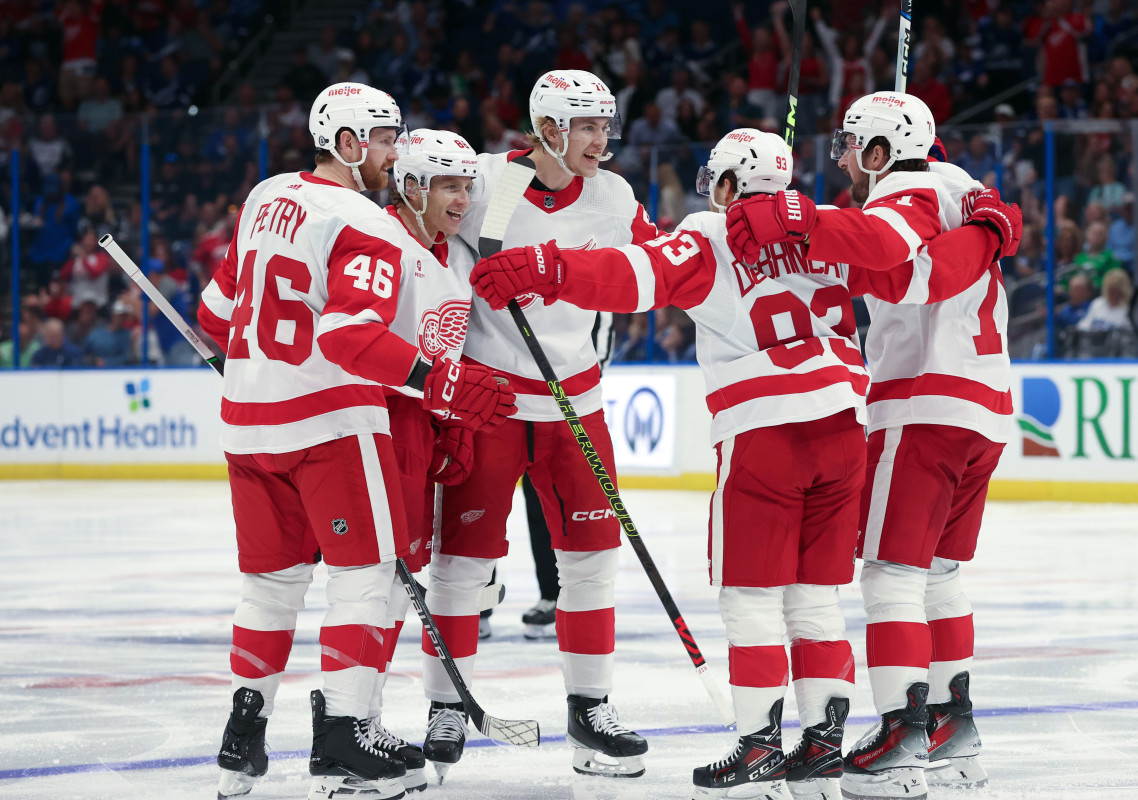Special players, special teams, special plays.
The Red Wings dedicated two of their three periods of Sunday’s Red & White Scrimmage to special teams scenarios, including a whole period of penalty kill vs. power play and extensive three-on-three play. And while the exact units sketched onto the line sheet aren’t exactly matching what might happen on opening night, the scrimmage gave a good sense of where these units currently stand coming out of the offseason.
Here are four special teams questions after the scrimmage, including topics of Moritz Seider’s usage, Tyler Motte’s talent and more.
Mandatory Credit: Jayne Kamin-Oncea-Imagn Images
Can the Red Wings’ Power Play Tap into Old Chicago Chemistry?
Patrick Kane said Red Wings free agent signing Erik Gustaffson holds his own with the best power play pointmen he has played with in his career. The Red Wings put that high praise into action, reuniting Kane and Gustafsson with Alex DeBrincat on their top power play. That trio played together for an effective unit in 2019 with Chicago, finishing the season at a 20.2% conversion rate ranking 15th in the NHL.
The big question with Detroit’s power play is whether they can tap back into that mojo with ease.
“That’s real,” Lalonde described Saturday of the connection between the three players. “Probably even went into the signing. You get the players, one of a coach’s first exercises is to watch them from their past.”
Lalonde isn’t just copying the Blackhawks’ homework here. There’s an evident connection between the three players that showed up in the scrimmage. With all three on the perimeter of the power play, Dylan Larkin at bumper and Lucas Raymond at the net front, the Chicago alumni moved the puck well to each other and developed a handful of chances. Detroit would probably like to see them score — the unit actually went negative by allowing Tyler Motte to score a shorthanded goal against them. But, the skeleton of what they once had in Chicago showed.
Keying in on Gustafsson, Lalonde specifically likes the way that he finds Kane with time and space to utilize off his elite half wall play, while Gustafsson also seems to find DeBrincat’s “sweet spot” as a shooter. Gustafsson’s efficacy isn’t so much about what he can do as an individual, but more so the way he can help elite teammates reach their potential to score. Whereas last season’s top unit quarterback Shayne Gostisbehere could make a lot of individual moves, Gustafsson is much more reserved at the point.
Even if Gustafsson might not stir the drink, he puts the spoon in the hand of the players who will. If he can continue to do that, that bodes well for Detroit’s top unit.
Mandatory Credit: John E. Sokolowski-USA TODAY Sports
What Can Penalty Killers Learn from Teammate Tyler Motte?
Tyler Motte not only blanked the Red Wings’ top power play in his PK reps. He outscored them. Picking off a turnover and carrying it in on a breakaway, Motte scored a shorthanded goal in the second period.
Teammates and coaches have praised Motte all week, and this shorthanded effort is exactly why he was brought in by the Red Wings. It’s also something his teammates can learn from.
“First and foremost, the pride he takes in it,” Lalonde said of the lessons drawn from Motte’s game. “He understands the identity of it, his role in it. He was licking his chops for reps today. … We foresee him being very valuable and helping us a ton on the penalty kill.”
Lalonde also praised the speed in Motte’s game, which he flashed on the shorthanded goal. It’s also what allows him to get on top of his power play opposition, as well as cover a lot of space with an outstretched stick.
Motte was one of the NHL’s best penalty kill specialists last season. At 4-on-5, he ranked fifth among consistent PK forwards in shot attempts against per 60 at 92.66 as tracked by Moneypuck. PK linemate and former Red Wing Luke Glendening ranked just ahead of him at fourth. Motte also led the NHL with the fewest high danger chances surrendered per 60 at just 5.28. Those numbers are both outstanding in context of fellow NHLers.
In a way, penalty killers are almost akin to cornerbacks in the NFL in the way their position relies so heavily on the tangible speed and the intangible attitude. Of course, being quick and nimble like Motte helps put him in position to lock up his opponents, but it also takes a certain attitude to not get beaten. Effort is what it takes to live on an island and thrive, and it’s something Motte shows so well in his game.
“PK is my favorite part of the game,” Motte said Saturday. “Not the most sexy part, but I appreciate the competitive nature of it — being down a guy, trying to get a job done, momentum swings and what it can create on the momentum side for the group. It’s something I’ve always hung my hat on.”
If Motte is individually good at blending skill and effort, the question becomes how this might rub off on his peers. Especially for younger peers such as Joe Veleno, Motte could help them take their next step as a penalty kill role player. That could make Motte even more valuable to the Red Wings than he already is.
Mandatory Credit: Rick Osentoski-USA TODAY Sports
Where Will Moritz Seider Fit into these Units?
Moritz Seider won’t join the Red Wings until they return to Detroit, meaning he couldn’t take part in Sunday’s scrimmage. So where might he have fit in?
For the penalty kill, it seems clear that Seider would have played next to Ben Chiarot, as he often did when the two were a defense pairing last season. Justin Holl occupied that right-handed spot beside Chiarot in the scrimmage, playing at times with PK forward duo of Dylan Larkin and Lucas Raymond. Seider would be a natural replacement for Holl in that quartet.
On the power play, Seider’s usage opens up a broader question of who might quarterback Detroit’s power plays. Seider ran the second unit last season while Shayne Gostisbehere ran the first. He scored 17 points to Gostisbehere’s 22 in about 80 fewer minutes of ice time. In the previous two seasons, Seider quarterbacked the top unit.
Seider is going to get power play time, but the question is which unit he runs. In terms of hierarchy, it appears as though Seider and Gustafsson are the leading candidates to run the top two units, but Gustafsson’s aforementioned chemistry with Kane and DeBrincat might push him into the leading role.
Another contender for power play time could be Simon Edvinsson. Playing on a unit that included Vladimir Tarasenko and J.T. Compher, the defenseman created a goal during the scrimmage with a blast from up top. Either Edvinsson scored the power play goal himself, or Veleno might have tipped it. Either way, the resulting tally on the scoreboard speaks to the way that Edvinsson could impact the special teams units.
This impact is a long time coming. One of the reasons Edvinsson stayed in Grand Rapids to start last season — besides the way it eased a roster headache — was that Detroit wanted to see him get more experience running a power play. He got that, and it showed up in training camp. Be that as it may, Edvinsson will have to go through Seider and Gustafsson to get minutes. There isn’t a clear path there.
Back to Seider, it would be shocking to see him removed from the power play, so don’t bank on that happening. For now, it appears as though he may remain on the second unit.
Mandatory Credit: Nick Turchiaro-USA TODAY Sports
How Can 3-on-3 Units Earn Extra Points in Overtime
If the Red Wings had won one more overtime last season, we’d be talking about a playoff team. Instead, they missed by one point. Winning games in overtime matters.
Last season, Detroit went 13-9 in games that went to overtime or the shootout, including three straight wins to end the season. That’s not a bad record, but any one of those nine losses could’ve been a win with better 3-on-3 play in overtime. So how did those 3-on-3 units look in the scrimmage?
Most of these units paired a pair of forwards with high chemistry together. Dylan Larkin stuck with Lucas Raymond. Andrew Copp played with linemate Michael Rasmussen. J.T. Compher and newcomer Vladimir Tarasenko buddied up. Even Alex DeBrincat and Patrick Kane got a rep. When one mistake or misread can end a game, it’s evident that Detroit likes its forwards to have lots of familiarity. The defensemen on the back end tended to cycle.
How exactly this changes when the whole team is together remains to be seen, but it’s probable that these duos will remain together. They all traded a few chances, but none of them scored at 3-on-3. In other words, no one called game.
As for the overall style of hockey at 3-on-3, players played with consistent pace, chasing the chance to score rather than limiting the chance to get scored on. Take this with a grain of salt given the nature of a scrimmage means there weren’t really stakes to this game, but this lack of hesitation was notable. Players were trying to win the game.
The pace of overtime play has been a point of contention among NHL observers for some time, with NHL GMs discussing a potential over-and-back rule that would prevent players from constantly circling out of their attacking zone in overtime. This would be similar to the NBA’s backcourt violation. Nothing came of this at March’s GMs meeting, but the idea remains.
So what do the Red Wings think about this potential change? Lalonde said he has “no strong feelings” and said he trusts the NHL’s rules committee to come to the right conclusion.
“You can even see how 3-on-3 has evolved,” Lalonde explained. “It’s funny, you get some video from when it was first introduced, how chaotic it was. Now, it’s a lot more in control. Like anything else, coaches and players have figured some things out. But I’m comfortable where 3-on-3 overtime is at. I’d understand changing the rule, too.”
As long as the rule remains the same, the Red Wings have to try to win games under it. If the low-stakes Red & White Game offered some slight observation, they’ve got no problem taking their chances to win.
Also from THN Detroit
Red & White Game Notebook
Red Wings’ Third Line Picking Up Where it Left Off
Ville Husso Feels “110%,” Looking to Bounce Back from Injury-Filled Season
“Any Game Could Be the Difference”: Compher Brings Playoff Intensity to Detroit Training Camp
Notebook: Odds and Ends from the First Half of Red Wings Training Camp
Teach a Man to Fish: How Jeff Petry’s Impact on Red Wings Extends Past His Own Play
“If He Earns More Minutes, He’ll Get More Minutes”: Red Wings Ready for Big Year from Edvinsson



